
The Merchants Exchange building (1842-1890) in Boston, Massachusetts was built in 1841 from a design by architect Isaiah Rogers. Centrally located on State Street, it functioned as a hub for business activities in the city.

The Merchants Exchange building (1842-1890) in Boston, Massachusetts was built in 1841 from a design by architect Isaiah Rogers. Centrally located on State Street, it functioned as a hub for business activities in the city.
The Merchants Exchange served as one of Boston's "great gathering-points of the traders -- the marble-paved and frescoed hall ... with its newspaper files, bulletins, wind vane, and ship registry." [1] It was "elegant ... with a fine reading-room, ... and besides accommodations for the post office, and for several insurance and brokers' offices, affords many conveniences for the mercantile community." [2]
Built in 1841-1842 by architect Isaiah Rogers, Merchants Exchange was considered "among the best specimens of architecture in Boston" [3] and "a dignified building in its day." [4] Re-modelling occurred after the building "went down" in the fire of 1872. [5] [6]
After 1890, the "Exchange Building" occupied the site of the former Merchants Exchange building. [7]
The building housed business activities, such as:
Isaiah Rogers was an American architect from Massachusetts who eventually moved his practice south, where he was based in Louisville, Kentucky, and Cincinnati, Ohio. He completed numerous designs for hotels, courthouses and other major buildings in Boston, Massachusetts, and New York City, before that relocation.

Tremont House, sometimes called the Tremont Hotel, was a hotel designed in 1829 by Isaiah Rogers in Boston, Massachusetts. Notable guests included Davy Crockett and Charles Dickens.

The Tremont Theatre (1827–1843) on 88 Tremont Street was a playhouse in Boston. A group of wealthy Boston residents financed the building's construction. Architect Isaiah Rogers designed the original Theatre structure in 1827 in the Greek Revival style. The playhouse opened on 24 September 1827.
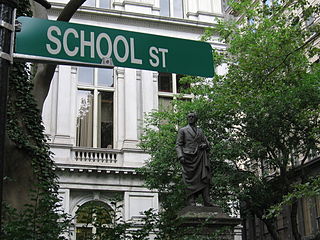
School Street is a short but significant street in the center of Boston, Massachusetts. It is so named for being the site of the first public school in the United States. The school operated at various addresses on the street from 1704 to 1844.

The Boston Museum (1841–1903), also called the Boston Museum and Gallery of Fine Arts, was a theatre, wax museum, natural history museum, zoo, and art museum in 19th-century Boston, Massachusetts. Moses Kimball established the enterprise in 1841.

The Hollis Street Church in Boston, Massachusetts, was a Congregational and Unitarian church. It merged with the South Congregational Society of Boston in 1887.
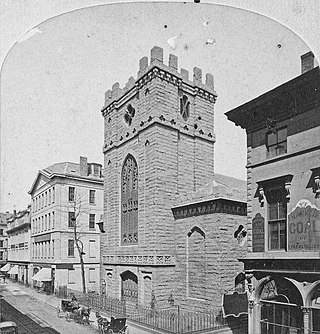
Trinity Church (1735-1872) was an Episcopal church in Boston, Massachusetts, located on Summer Street. It housed Boston's third Anglican congregation. The Great Fire of 1872 destroyed the church building, and by 1877 the congregation moved into a new building in Back Bay.

Alexander Rice Esty was an American architect known for designing many Gothic Revival churches in New England, however his work also encompassed university buildings, public buildings, office buildings, and private residences across the Northeastern United States.
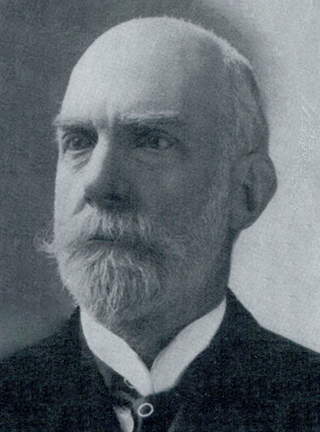
William Gibbons Preston was an American architect who practiced during the last third of the nineteenth century and in the first decade of the twentieth. Educated at Harvard University and the École des Beaux-Arts in Paris., he was active in Boston, New York, Rhode Island, Ohio, New Brunswick and Savannah, Georgia, where he was brought by George Johnson Baldwin to design the Chatham County courthouse. Preston stayed in Savannah for several years during which time designed the original Desoto Hotel, the Savannah Volunteer Guards Armory and 20 other distinguished public buildings and private homes. He began his professional career working for his father, the builder and architect Jonathan Preston (1801–1888), upon his return to the United States from the École in 1861, and was the sole practitioner in the office from the time his father retired c. 1875 until he took John Kahlmeyer as a partner in about 1885.

Congress Street in Boston, Massachusetts, is located in the Financial District and South Boston. It was first named in 1800. It was extended in 1854 as far as Atlantic Avenue, and in 1874 across Fort Point Channel into South Boston. Today's Congress Street consists of several segments of streets, previously named Atkinson's Street, Dalton Street, Gray's Alley, Leverett's Lane, Quaker Lane, and Shrimpton's Lane.
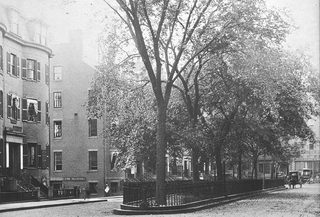
Pemberton Square in the Government Center area of Boston, Massachusetts, was developed by P.T. Jackson in the 1830s as an architecturally uniform mixed-use enclave surrounding a small park. In the mid-19th century both private residences and businesses dwelt there. The construction in 1885 of the massive John Adams Courthouse changed the scale and character of the square, as did the Center Plaza building in the 1960s.
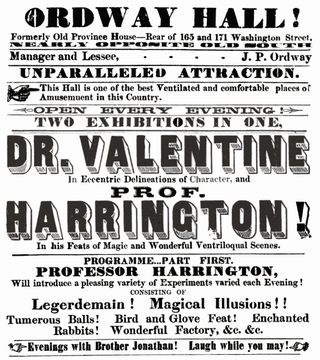
Ordway Hall (est.1852) was a theatre in Boston, Massachusetts located off Washington Street in the former Province House. John P. Ordway established and managed the hall, which specialized in "negro minstrelsy," particularly the Ordway Aeolians, his own troupe.
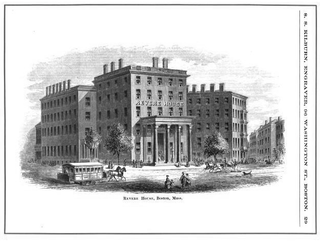
William Washburn (1808–1890) was an architect and city councilor in Boston, Massachusetts, USA, in the mid-19th century. He designed Boston's National Theatre (1836), Revere House hotel (1847), Tremont Temple (1853) and Parker House hotel (1854). He served on the Boston Common Council from ward 6 in 1854 and 1855. He was chairman of the Boston Board of Aldermen in 1855.

Cummings and Sears was an architecture firm in 19th-century Boston, Massachusetts, established by Charles Amos Cummings and Willard T. Sears.

The Globe Theatre (est.1871) was a playhouse in Boston, Massachusetts, in the 19th century. It was located at 598 Washington Street, near the corner of Essex Street. Arthur Cheney oversaw the Globe until 1876. From 1871-1873 it occupied the former theatre of John H. Selwyn. After a fire in May 1873, the Globe re-opened on the same site in December 1874. Architect Benjamin F. Dwight designed the new building. From 1877-1893 John Stetson served as proprietor; some regarded him as "a theatrical producer with a reputation for illiteracy in his day such as Samuel Goldwyn has achieved" in the 1960s. The theatre burned down in January 1894.
The Beacon Theatre was a cinema on Tremont Street in Boston, Massachusetts built in 1910 and closed in 1948. Jacob Lourie established it. Architect Clarence Blackall designed the building, with its 500-seat auditorium which a contemporary critic described as "showy." It had a staff of 26 in 1910. In 1948 the "refurbished" building became the Beacon Hill Theater. The building existed until 1970.

Steinert Hall of Boston, Massachusetts, stands at 162 Boylston Street on what was called Boston's "piano row", opposite the Common in the Boston Theater District.

Horticultural Hall (1845-1860s) of Boston, Massachusetts, stood at no.40 School Street. The Massachusetts Horticultural Society erected the building and used it as headquarters until 1860. Made of granite, it measured "86 feet in length and 33 feet in width ... [with] a large hall for exhibitions, a library and business room, and convenient compartments for the sale of seeds, fruits, plants and flowers." Among the tenants: Journal of Agriculture; Azell Bowditch's seed store; and Morris Brothers, Pell & Trowbridge minstrels.

The Boston Evening Traveller (1845–1967) was a newspaper published in Boston, Massachusetts. It was a daily newspaper, with weekly and semi-weekly editions under a variety of Traveller titles. It was absorbed by the Boston Herald in 1912, and ceased publication in 1967.

Richard Bond (1798–1861) was an early American architect who practiced primarily in Boston, Massachusetts.
Coordinates: 42°21′31.33″N71°3′22.56″W / 42.3587028°N 71.0562667°W